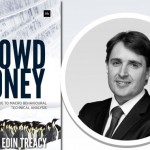Earnings – the lack of them – remain the biggest threat to American equities, whose recent strong growth has been driven by optimism and buy-backs rather than underlying profits, while the latter have come from cost-cutting, not growth in sales.
“First-quarter earnings growth is running at minus 1.3 per cent, according to FactSet – well shy of Wall Street’s sunny forecast of a 4.4 per cent gain back in January,” Michael Mackenzie reports in the FT.
The earnings cycle is the weakest in 55 years, says Jeffrey KIeintop, a strategist at LPL Financial, with average earnings having risen only 20 per cent from their prior peak, compared to gains of 50 to 70 per cent in previous cycles.
Wall Street does expect a strong pick-up in profits ground in the second half of this year. However, Mackenzie says, if the “rosy earnings forecasts don’t
materialize in the coming quarters and the Fed ends QE [money ‘printing’], rougher water is the destination for equity bulls.”
Things are very different in Asia.
Investment bank CLSA says it expects earnings of the 851 companies in the universe of the Asia-Pacific excluding Japan that it covers, to grow by 8 per cent this year. It’s forecasting return-on-equity of 13.6 per cent this year.
Asia also offers defensive quality as its companies are paying higher dividends, two-and-a-half times covered by earnings.
Once again global bond markets have made fools of the perennial pessimists and rewarded the handful of optimists like myself.
20-year US Treasuries have delivered a total return of more than 12 per cent this year, the equivalent German Bunds an amazing 18 per cent.
Longdated government bonds has outperformed both equities and lower-rated company paper since the year began. Why?
Institutional money seems to have switched out of riskier assets after the sharp rise in their values last year in anticipation of some weakness in those values this year. The lowest-risk “sovereigns” look attractive investments in an environment where there is no sign of the inflation that is bonds’ greatest enemy.
However, two of the world’s most important markets in sovereign debt have parted company in over the past year. The FT reports: “Bund yields have fallen to their lowest level against their benchmark US counterpart in nearly eight years, as investors anticipate contrasting central bank policies in the coming months.”
The US Federal Reserve is “tapering” – slowly trimming back its extreme easy-money policy – while in Europe the central bank is expected to do the reverse, and switch to more aggressive stimulation.
Bond values move inversely to their yields, and lower yields indicate greater investor preference. The longdated German paper was recently trading around 2.37 per cent, the American equivalent at 3.51 per cent.
CopyRight – OnTarget 2014 by Martin Spring




